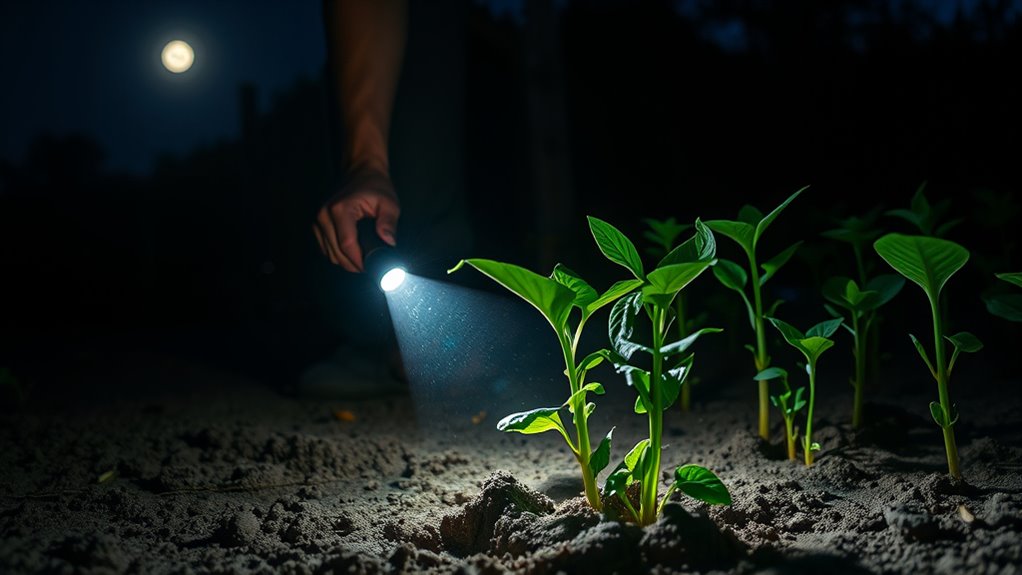To deter cutworms during nighttime patrols, start by inspecting seedlings closely for damage like wilting, ragged leaves, or soil tunnels. Use a strong flashlight and tools like tweezers to identify pests and signs of infestation. Set up physical barriers such as fine mesh or row covers, and consider natural repellents like garlic spray or companion plants. Consistently monitor pest activity to adjust your strategies, and discover more effective tips as you continue to watch for pest patterns.
Key Takeaways
- Conduct regular nighttime inspections using a flashlight to spot cutworms around seedlings and soil entrances.
- Install physical barriers like fine wire mesh or row covers during evening hours to prevent cutworm access.
- Use natural deterrents such as garlic or hot pepper sprays, applying them before dusk to repel pests.
- Record pest sightings and damage patterns to identify peak activity times and adjust patrol frequency accordingly.
- Combine physical barriers with companion planting and soil health practices for long-term cutworm management.
Recognizing Cutworm Damage and Signs of Infestation

To effectively protect your seedlings, you need to learn how to recognize cutworm damage and identify signs of infestation. Pest identification is vital, as cutworms leave distinctive damage symptoms. Look for sudden wilting or browning of seedlings, often with the plant stem cut near the soil line. You might notice chewed or ragged edges on young leaves, indicating feeding activity. During evening or nighttime checks, gently lift plants to see if cutworms are curled around the stems or hiding beneath soil mulch. Keep an eye out for loose or missing soil around seedlings, which can reveal tunnel entrances. Recognizing these damage symptoms early helps you take swift action to prevent further infestation and protect your garden’s health. Using pest control methods, such as physical barriers or organic repellents, can further assist in managing cutworm problems effectively.
Essential Tools and Equipment for Nighttime Checks

Conducting effective nighttime checks for cutworms requires having the right tools on hand. You’ll need basic garden tools like a flashlight with a strong beam, a hand trowel or small fork to inspect soil close to seedlings, and perhaps a pair of tweezers for removing any pests. Protect yourself by wearing sturdy gloves and protective gear such as a hat or long sleeves to avoid bites or skin irritation. A notebook or smartphone can help you record observations quickly. These tools guarantee you can thoroughly examine the soil and seedlings without disturbance, increasing your chances of spotting cutworms early. Being aware of integrating technology into your garden routine can further enhance your pest management strategies. Having everything ready before night patrols makes your checks more efficient and effective in protecting your seedlings from damage.
Best Practices for Conducting Effective Night Patrols

Preparing thoroughly before your night patrols guarantees you’re ready to spot and handle cutworms effectively. Start by familiarizing yourself with signs of infestation, such as damaged seedlings or soil disturbances. Maintain good soil health through proper aeration and organic matter, which makes it easier to identify pests and encourages healthy plant growth. Use crop rotation to reduce cutworm populations, as they tend to favor certain crops. During patrols, move slowly and methodically, inspecting soil around seedlings and looking for cutworms or their cast skins. Keep a flashlight handy to reveal hidden pests in the soil. Document your findings to track patterns and adjust your strategies. Consistent, attentive patrols help prevent infestations and protect your seedlings from damage. Additionally, understanding industry trends can help you stay informed about emerging pest control methods and innovations.
Physical Barriers and Protective Measures to Keep Cutworms Away

Implementing physical barriers is one of the most effective ways to keep cutworms away from your seedlings. Using wire mesh around your plants creates a sturdy barrier that prevents cutworms from reaching the stems at night. Make certain the mesh is fine enough to block even the smallest pests. Additionally, draping row covers over your seedlings provides a protective shield during nighttime hours. These covers allow sunlight and air to pass through while keeping cutworms at bay. Secure the edges tightly to prevent pests from slipping underneath. Both wire mesh and row covers are simple, chemical-free solutions that protect your plants effectively. By installing these barriers early, you reduce the risk of damage and give your seedlings a healthy start. Also, monitoring economic conditions can help anticipate potential pest outbreaks influenced by environmental factors.
Natural Deterrents and DIY Repellents for Nighttime Use

You can try using companion planting to repel cutworms naturally, placing certain plants near your seedlings. Homemade repellents, like garlic or hot pepper sprays, offer an easy, chemical-free solution for nighttime protection. Additionally, installing simple light or sound barriers can discourage these pests from approaching your young plants. To enhance effectiveness, consider using light control techniques that can further deter nocturnal pests from your garden.
Companion Planting Strategies
Companion planting offers an effective natural approach to deterring cutworms from seedlings at night. By pairing vulnerable plants with certain companions, you create a hostile environment for pests. For example, planting marigolds near seedlings can repel cutworms, while adding soil amendments like compost improves plant resilience. You can also incorporate herbs such as dill or thyme, which deter pests naturally. To help you plan, here’s a simple table with companion options:
| Plant to Deter | Companion Planting Benefits |
|---|---|
| Marigolds | Repels cutworms, attracts beneficial insects |
| Nasturtiums | Acts as trap crop, distracts pests |
| Dill | Deters cutworms, attracts beneficial insects |
| Thyme | Repels pests, enhances soil health |
Using these strategies in your flower bed strengthens your defenses and encourages healthy growth. Additionally, integrating essential oils like neem or citronella into your nighttime patrol routine can further deter pests naturally.
Homemade Repellent Recipes
Homemade repellents offer a simple and effective way to keep cutworms away from seedlings at night. You can create natural repellents using common household ingredients, making homemade sprays that deter pests without chemicals. For example, a garlic and hot pepper spray can be made by blending garlic cloves, hot peppers, and water, then straining and spraying around your plants. Another effective natural repellent involves soaking neem or citrus peels in water overnight and applying the solution to seedlings. These homemade sprays produce strong scents that cutworms dislike, reducing their interest in your plants. Using natural repellents not only protects your seedlings but also minimizes environmental impact and keeps your garden organic. Regular application during the evening helps maintain a pest-free garden environment, and incorporating homemade repellents can be a cost-effective and eco-friendly pest management strategy.
Light and Sound Barriers
Light and sound barriers can be highly effective natural deterrents against cutworms during nighttime. By using motion-activated lights or devices that emit sounds, you can disrupt their behavior without harmful chemicals. Incorporate garden decor like reflective tape or solar lights to create visual distractions that mimic predators, exploiting pest biology to deter cutworms. These barriers interfere with their ability to feed and move freely at night, reducing damage to seedlings. Since cutworms are most active in darkness, disrupting their environment with light or sound can considerably lower their presence. DIY options, such as noise makers or reflective materials, are inexpensive and easy to set up, making them practical solutions for maintaining a pest-free garden while keeping it attractive and natural. Additionally, understanding pest behavior can help you develop more targeted and effective deterrent strategies.
Monitoring and Adjusting Strategies for Long-Term Control

To keep cutworm control effective over time, you need to monitor pest activity regularly. Adjust your patrols based on when and where you see the most damage, and keep detailed records of your findings. Analyzing this data helps you refine your strategies and stay one step ahead of the pests. Incorporating preventative measures like physical barriers or biological controls can further enhance your long-term management plan.
Track Pest Activity Patterns
Tracking pest activity patterns is essential for effective long-term control of cutworms. By observing their behavior, you gain insights into their pest lifecycle, which helps you time your patrols better. Since cutworms exhibit nocturnal behavior, you’ll notice increased activity after sunset, making nighttime monitoring vital. Keep a detailed record of when you spot signs of cutworm feeding or larvae presence, noting the time and conditions. This information reveals peak activity periods, allowing you to adjust your patrols accordingly. Understanding their nocturnal habits also helps you identify the most vulnerable times to intervene. Regularly monitoring pest activity can help you adapt your strategies effectively over time. Consistent tracking and data collection empower you to develop targeted strategies, reducing the risk of infestations and protecting your seedlings effectively over the long term.
Adjust Patrol Frequency
How often should you check your seedlings to stay ahead of cutworm activity? Regular patrol scheduling is essential. During peak infestation periods, check your seedlings every 2-3 nights, especially after rain or warm evenings when cutworms are most active. If you receive infestation alerts from previous patrols, increase inspection frequency to nightly until the risk diminishes. As cutworm activity subsides, you can extend patrol intervals to every 3-4 nights, but always stay vigilant. Adjusting patrol frequency based on pest activity helps you catch early signs of infestation and reduces damage. Consistent monitoring ensures you respond promptly, preventing widespread damage and maintaining healthy seedlings for the long term.
Record and Analyze Findings
Keeping detailed records of your patrols and findings allows you to identify patterns in cutworm activity over time. By tracking when and where garden pests are most active, you can better time your patrols and adjust your strategies accordingly. Analyzing these records helps you spot trends that may relate to soil health, such as increased pest presence after soil disturbances or poor drainage. Regularly reviewing your data enables you to refine your approach, potentially incorporating additional soil amendments or cover crops to improve soil health and reduce cutworm attraction. Over time, these insights lead to more effective long-term control, minimizing damage to seedlings. Consistent record-keeping turns your efforts into a strategic, informed plan for managing cutworms and supporting a healthy garden ecosystem.
Frequently Asked Questions
How Often Should Nighttime Patrols Be Scheduled During Peak Cutworm Activity?
During peak cutworm activity, you should schedule nighttime patrols every 2 to 3 nights to make certain effective monitoring. Maintaining timing consistency helps you detect cutworms early and prevent damage. Keep patrols brief, around 15-20 minutes, focusing on vulnerable seedlings and soil surface. Regular patrols allow you to spot and remove cutworms promptly, reducing the risk of infestation and protecting your garden’s health efficiently.
What Are the Most Common Mistakes to Avoid During Night Patrols?
When conducting night patrols, you should avoid common mistakes like improper lighting and inconsistent timing. Confirm your lighting is proper—bright enough to spot cutworms but not so harsh that it frightens pests away. Stick to consistent timing every night to develop a routine, making it easier to catch cutworms in action. Skipping patrols or varying your schedule can reduce effectiveness, so stay disciplined and attentive.
Are There Specific Weather Conditions That Increase Cutworm Activity?
You might notice cutworm activity increases during specific weather conditions. Warm soil with high moisture levels creates an ideal environment, especially when temperature fluctuations occur at night. These conditions encourage cutworms to come out of their burrows in search of food. To protect your seedlings, monitor soil moisture and temperature patterns, and plan your nighttime patrols accordingly, especially after rainy or warm spells, when activity tends to peak.
Can Companion Planting Help Deter Cutworms Effectively?
Companion planting can help deter cutworms naturally when you choose plants that repel pests or attract beneficial insects. Incorporate natural repellents like marigolds or garlic near your seedlings to create a barrier. These plants emit strong scents that cutworms dislike, making them less likely to attack. Regularly rotating and diversifying your garden with companion plants enhances this strategy, providing an eco-friendly way to protect your seedlings effectively.
How Do I Identify Different Types of Cutworms at Night?
Identifying cutworms at night is like decoding a shadowy mystery. You look for larvae identification clues such as their size, color, and shape—usually, a smooth, cylindrical body with a cutworm’s distinct head. Since they’re nocturnal, their behavior is key; they hide during the day and emerge after sunset. Monitoring your seedlings at night helps you spot their movements and distinguish different types of cutworms before they cause damage.
Conclusion
By staying vigilant and patrolling your seedlings at night, you become a shepherd guiding your garden through the darkness. Just like a lighthouse keeps ships safe in stormy seas, your regular checks can steer cutworms away before they cause real damage. With the right tools and strategies, you’ll protect your plants effectively. Remember, consistent effort is your best defense—think of it as shining a light that keeps those pesky cutworms at bay, ensuring a thriving garden.









